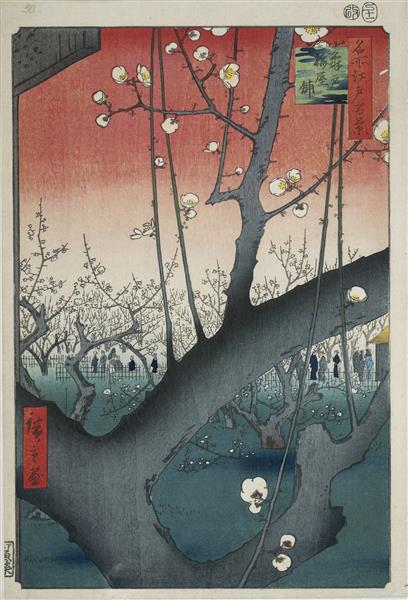Description
The work "Plum Park in Kameido" (1857) by Utagawa Hiroshige is a sublime expression of the ukiyo-e style, which captured the attention of the public both in its time and today. This painting is set within the Edo period, an era characterized by its cultural and artistic flourishing. Hiroshige, recognized as one of the great masters of Japanese printmaking, offers in this work a vivid representation of the landscape, marking the passage of time through the seasons, a recurring theme in his work.
The composition of the painting is notable for its balance and harmony. In the foreground, a group of flowering plums extends toward the viewer, offering a close-up view of their delicate branches and pink flowers. This direct approach invites a sensory immersion into the scene, suggesting the fragility and ephemeral beauty of life. The arrangement of the trees guides the gaze toward a background that resembles a spatial fugue, where the presence of more distant hills and a sky that, although serene, seems to foretell the arrival or passing of a gentle rain is hinted at.
The use of color in "Plum Park in Kameido" demonstrates Hiroshige's mastery. The soft tones of pink contrast with the blue of the sky and the greenish hues of the vegetation, creating a cheerful and balanced landscape. The flowering plums are not only a visual spectacle but also symbolize the arrival of spring, a theme laden with meaning in Japanese culture, often representing the transience of life. This connection to natural cycles is fundamental in Hiroshige's production, who skillfully evokes the feeling of change and renewal.
In the work, human figures are not observable, which is characteristic of Hiroshige's style in his landscapes. However, the absence of human characters seems to intensify the emotional connection that the viewer can feel with the surrounding nature. This reflects an important aspect of Japanese thought: the idea that nature and humanity coexist in a relationship of respect and contemplation. The image invites the viewer to reflect and connect with the beauty of the natural environment, an invitation to immerse oneself in an experience of tranquility.
This painting is part of a series that captures different scenarios of the Japanese landscape, where Hiroshige explored the beauty of seasonal changes and life in the rural hubs of Japan. "Plum Park in Kameido" is a clear example of his sensitivity to the environment and his ability to translate those observations into art. The series it is included in, "The Fifty-Three Stations of Tōkaidō" and other similar works, present the same level of detail and emotion that characterizes Hiroshige, who with his unique approach managed to immortalize beautiful landscapes that transcend their time and space.
Thus, "Plum Park in Kameido" is not only a masterpiece of ukiyo-e but also resonates with the ability of art to evoke the soul of its time and place. The serenity of the scene and the exquisiteness of the details make this painting an essential piece for understanding Hiroshige's legacy and his contribution to Japanese art. His work continues to inspire and delight generations of art lovers, reminding us of the power of nature and beauty in the everyday.
KUADROS ©, a famous painting on your wall.
Hand-made oil painting reproductions, with the quality of professional artists and the distinctive seal of KUADROS ©.
Reproduction service of paintings with a satisfaction guarantee. If you are not completely satisfied with the replica of your painting, we will refund 100% of your money.

